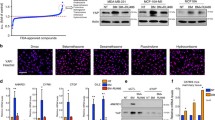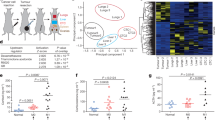Abstract
The aggressive behavior of breast cancer cells can at times be modulated by hormonal mechanisms. Exposure to glucocorticoids (GC) has been shown to stimulate the invasiveness, motility and adhesiveness of breast cancer cells containing the glucocorticoid receptor. This is largely explained by GC-associated overexpression of the c-fms proto-oncogene, which encodes the receptor for the colony stimulating factor-1 (CSF-1). Our objective is to investigate additional GC-associated genetic alterations that could modulate c-fms related malignant behavior in breast cancer cells. A microarray technique using an oligonucleotide array representing 16,700 known expressed human genes was used to analyze the gene expression profile of breast cancer cells exposed to dexamethasone (Dex) or vehicle. Results were confirmed by western blot analysis. Six genes were found to be consistently differentially overexpressed in the Dex-exposed cells compared to control. We focused on serum-glucose kinase 1 (SGK1), a serine-threonine kinase known to be involved in intracellular signal transduction pathways and induced by GC and serum. An adhesion assay was performed on extracellular matrix after exposing the breast cancer cells to Dex, CSF-1 or to Dex or CSF-1 plus LY294002, a functional inhibitor of SGK1 action. Exposure to LY294002 significantly decreased both CSF-1 and Dex-induced adhesiveness to the level of control cells. SGK1 may act as a downstream intracellular regulator of c-fms, particularly of c-fms-induced adhesiveness of breast cancer cells after exposure to GC or CSF-1. This finding may have implications for potential therapeutic interventions aimed at decreasing the aggressiveness of breast cancer cells.
Similar content being viewed by others
References
Jemal A, Murray T, Samuels A et al. Cancer statistics, 2003. CA Cancer J Clin 2003;53:5–26.
Carter CL, Allen C, Henson DE. Relation of tumor size,lymphnode status,and survival in 24,740 breast cancer cases. Cancer. 1989;63:181–7.
Maher MG, Sapi E, Turner B et al. Prognostic signi cance ofcolony-stimulating factor receptor expression in ipsilateralbreast cancer recurrence. Clin Cancer Res 1998;4:1851–6.
Scholl SM, Pallud C, Beuvon F et al. Anti-colony-stimulatingfactor-1 antibody staining in primary breast adenocarcinomascorrelates with marked inflammatory cell in ltrates and prognosis. J Natl Cancer Inst 1994;86:120-6.
Sapi E, Flick MB, Rodov S et al. Independent regulation of invasion and anchorage-independent growth by different auto-phosphorylation sites of the macrophage colony-stimulating factor 1 receptor. Cancer Res 1996;56:5704-12.
Chambers SK, Wang Y,Gilmore-Hebert M et al. Post-tran-scriptional regulation of c-fms proto-oncogene expression bydexamethasone and of CSF-1 in human breast carcinomasin vitro. Steroids 1994;59:514-22.
Sapi E, Flick MB, Gilmore-Hebert M et al. Transcriptional reg-ulation of the c-fms (CSF-1R)proto-oncogene in human breastcarcinoma cells by glucocorticoids. Oncogene 1995;10:529-42.
Filderman AE, Bruckner A, Kacinski BM et al. Macrophagecolony-stimulating factor (CSF-1)enhances invasiveness inCSF-1 receptor-positive carcinoma cell lines. Cancer Res 1992;52:3661-6.
Azodi M, Roy WJ, Chambers JT et al. Inhibition of invasive-ness and motility of ovarian and breast cancer cells by oligomertherapy directed towards the c-fms proto-oncogene. Proc Int Gynecol Cancer Soc 1999.
Toy EP, Bonafe N, Savlu A et al. Correlation of tumor pheno-type with c-fms proto-oncogene expression in an in vivo intra-peritoneal model for experimental human breast cancermetastasis. Clin Exp Metast,submitted.
Sapi E, Flick MB, Rodov S et al. Ets-2 transdominant mutantabolishes anchorage-independent growth and macrophage col-ony-stimulating factor-stimulated invasion by BT20 breast car-cinoma cells. Cancer Res 1998;58:1027–33.
Park J, Leong ML, Buse P et al. Serum and glucocorticoid-inducible kinase (SGK)is a target of the PI 3-kinase-stimulatedsignaling pathway. EMBO J 1999;18:3024–33.
Brunet A, Park J, Tran H et al. Protein kinase SGK mediatessurvival signals by phosphorylating the forkhead transcriptionfactor FKHRL1 (FOXO3a). Mol Cell Biol 2001;21:952–65.
Chambers SK. In vitro invasion assays. In Bartlett JMS (ed): Methods in Molecular Medicine.Totowa,New Jersey: HumanaPress 2000;179–86.
Webster MK, Goya L, Firestone GL. Immediate-early tran-scriptional regulation and rapid mRNA turnover of a putativeserine/threonine protein kinase. J Biol Chem 1993;268:11482–5.
Webster MK, Goya L, Ge Y et al. Characterization of sgk,anovel member of the serine/threonine protein kinase gene familywhich is transcriptionally induced by glucocorticoids and serum. Mol Cell Biol 1993;13:2031–40.
Mikosz CA, Brickley DR, Sharkey MS et al. Glucocorticoidreceptor-mediated protection from apoptosis is associated withinduction of the serine/threonine survival kinase gene,sgk-1. J Biol Chem 2001;276:16649–54.
Pirkl F, Buchner J. Functional analysis of the Hsp90-associatedhuman peptidyl prolyl cis/trans isomerases FKBP51,FKBP52and Cyp40. J Mol Biol 2001;308:795–806.
Hsu YP, Weyler W, Chen S et al. Structural features of humanmonoamine oxidase A elucidated from cDNA and peptidesequences. J Neurochem 1988;51:1321–4.
Shinozaki S, Nakamura T, Iimura M et al. Upregulation of Reg 1alpha and GW112 in the epithelium of in flamed colonicmucosa. Gut 2001;48:623–9.
Agarwal AK, Rogerson FM, Mune T et al. Gene structure andchromosomal localization of the human HSD11K gene encod-ing the kidney (type 2)isozyme of 11 beta-hydroxysteroid dehy-drogenase. Genomics 1995;29:195–9.
Kobayashi T, Deak M, Morrice N et al. Characterization ofthe structure and regulation of two novel isoforms of serum-and glucocorticoid-induced protein kinase. Biochem J 1999; 344Pt 1:189–97.
Brickley DR, Mikosz CA, Hagan CR et al. Ubiquitin modi ca-tion of serum and glucocorticoid-induced protein kinase-1(SGK-1). J Biol Chem 2002;277:43064–70.
Buse P, Tran SH, Luther E et al. Cell cycle and hormonal con-trol of nuclear-cytoplasmic localization of the serum-and gluco-corticoid-inducible protein kinase,Sgk,in mammary tumorcells.A novel convergence point of anti-proliferative andproliferative cell signaling pathways. J Biol Chem 1999;274:7253–63.
Wang J, Barbry P, Maiyar AC et al.SGK integrates insulinand mineralocorticoid regulation of epithelial sodium transport. Am J Physiol Renal Physiol 2001;280:F303–13.
Chambers SK, Ivins CM, Kacinski BM et al. An unex-pected effect of glucocorticoids on stimulation of c-fms proto-oncogene expression in choriocarcinoma cells expressing littleglucocorticoid receptor. Am J Obstet Gynecol 2004;190:974–85.
Leong ML, Maiyar AC, Kim B et al. Expression of the serum-and glucocorticoid-inducible protein kinase,Sgk,is a cell sur-vival response to multiple types of environmental stress stimuliin mammary epithelial cells. J Biol Chem 2003;278:5871–82.
Bourette RP, Myles GM, Choi JL et al.Sequential activationof phoshatidylinositol 3-kinase and phospholipase C-gamma2by the M-CSF receptor is necessary for differentiation signaling. EMBO J 1997;16:5880–93.
Kelley TW, Graham MM,Dose AI et al. Macrophage colony-stimulating factor promotes cell survival through Akt/proteinkinase B. J Biol Chem 1999;274:26393–8.
Grey A, Chen Y, Paliwal I et al. Evidence for a functional asso-ciation between phosphatidylinositol 3-kinase and c-src in thespreading response of osteoclasts to colony-stimulating factor-1. Endocrinol 2000;141:2129–38.
Lee AW, States DJ. Both src-dependent and-independentmechanisms mediate phosphatidylinositol 3-kinase regulation ofcolony-stimulating factor 1-activated mitogen-activated proteinkinases in myeloid progenitors. Mol Cell Biol 2000;20:6779–98.
Author information
Authors and Affiliations
Rights and permissions
About this article
Cite this article
Tangir, J., Bonafé, N., Gilmore-Hebert, M. et al. SGK1, a potential regulator of c-fms related breast cancer aggressiveness. Clin Exp Metastasis 21, 477–483 (2004). https://doi.org/10.1007/s10585-004-4226-8
Issue Date:
DOI: https://doi.org/10.1007/s10585-004-4226-8




